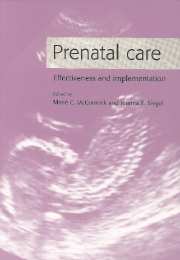Book contents
- Frontmatter
- Contents
- List of contributors
- Foreword
- Acknowledgments
- Introduction
- Part I Prenatal Care and Complications of Pregnancy
- Part II Preventing Prematurity
- Part III New Findings and Long-term Evidence on Intrauterine Growth Restriction
- 6 Causes of intrauterine growth restriction
- 7 Impact of prenatal care on intrauterine growth restriction
- 8 Short- and long-term outcomes of intrauterine growth restriction
- Part IV Preventing and Treating Birth Defects
- Part V Prenatal Care as an Integral Component of Women's Health Care
- Epilogue
- Index
7 - Impact of prenatal care on intrauterine growth restriction
Published online by Cambridge University Press: 17 August 2009
- Frontmatter
- Contents
- List of contributors
- Foreword
- Acknowledgments
- Introduction
- Part I Prenatal Care and Complications of Pregnancy
- Part II Preventing Prematurity
- Part III New Findings and Long-term Evidence on Intrauterine Growth Restriction
- 6 Causes of intrauterine growth restriction
- 7 Impact of prenatal care on intrauterine growth restriction
- 8 Short- and long-term outcomes of intrauterine growth restriction
- Part IV Preventing and Treating Birth Defects
- Part V Prenatal Care as an Integral Component of Women's Health Care
- Epilogue
- Index
Summary
Introduction
Intrauterine growth restriction (IUGR), a condition of poor intrauterine fetal growth, affects at least 200 000 pregnancies in the United States annually. It is a major cause of perinatal morbidity and mortality, accounting for over 30 000 fetal and neonatal deaths. Although the etiology of IUGR is complex and poorly understood, it can be recognized, evaluated, and treated, reducing perinatal mortality by over 50% (Hughey, 1984; Kurjak et al., 1980).
Prenatal care can have an important effect in four areas related to IUGR: prevention of unnecessary interventions for otherwise healthy, small infants; prevention of some cases of IUGR by treatment of maternal diseases and high-risk behaviors; diminution of perinatal morbidity and, perhaps, long-term morbidity associated with IUGR; and prevention of fetal death. This chapter describes these areas and details the prenatal care interventions that are most likely to reduce morbidity and mortality associated with IUGR, including accurate diagnosis of IUGR, early delivery, and prevention initiatives such as those related to sickle cell anemia, chronic hypertension, preventable congenital infections, and substance use.
Magnitude of the problem of IUGR
Theoretically, IUGR describes any fetus who fails to reach its full growth potential. Thus, in the strictest definition, the eight-pound term baby delivered of a multi-para who previously has had ten-pound babies is likely to have a degree of growth restriction. These infants, however, are rarely at risk for intrauterine or neonatal morbidity or mortality.
- Type
- Chapter
- Information
- Prenatal CareEffectiveness and Implementation, pp. 175 - 190Publisher: Cambridge University PressPrint publication year: 1999



